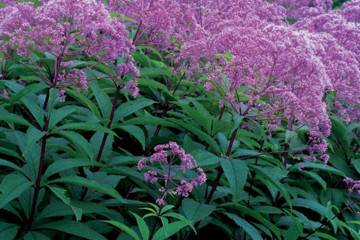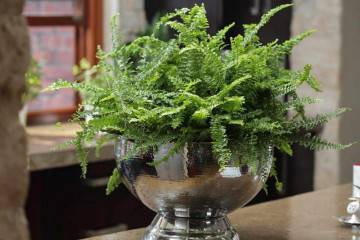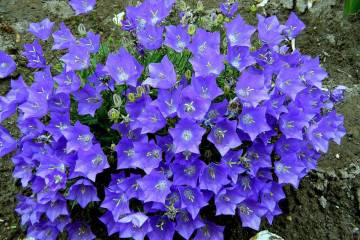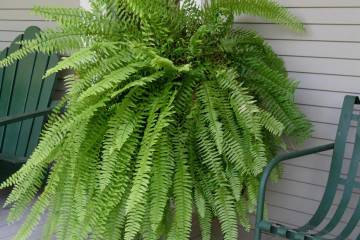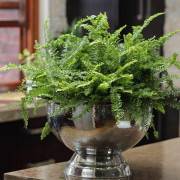Garden fern - planting and care
Content:
Many people want to decorate their site with decorative and unpretentious plants. Garden fern is a culture that does not require special care. The plant is decorative, goes well with flowers, is often used in rockeries and alpine slides. Therefore, many are interested in how to plant a fern correctly in order to get a beautiful site.
Garden fern - what is this plant
There are quite a lot of fern species. Exotic varieties are often grown at home; on the contrary, plants that can easily tolerate frost, heat, and rain are suitable for the garden. For planting, it is better to choose varieties from the same region, then you can be sure that the culture will take root and grow well.
Garden fern is a perennial plant with large spreading leaves, not poisonous. Sizes are varied: from the smallest to very tall Low maintenance, prefers shaded areas.
Combination with other plants in landscape design
Ferns are often used in landscape design to decorate the territory. When planting, it is recommended to take into account the presence of rapidly growing roots. In addition, the plant comes in a variety of sizes and can shade other flowers. Therefore, it is recommended to outline the location of the fern and other crops before planting.
Such plants are often used to decorate rutaria and rockeries, and are planted along the edges of artificial ponds. The fern in the garden is successfully combined with lilies, stretleafs. The use of different types will allow you to get a more decorative effect.
The culture is also used to decorate buildings and are planted along the walls.
What types are suitable for growing in the garden
There are about ten thousand species of fern. Some of these are the most popular for gardening.
Male shieldworm
One of the highest grades. The bushwort can reach one and a half meters in height, but it grows very slowly. Unpretentious plant, does not require special care. Perfect for decorating a plot. Propagated by parts of the rhizome.
Female kochedyzhnik
The most famous and beautiful fern. Possesses openwork large leaves, collected in a large bunch. Vai can reach 1 m, while remaining the same airy.
Bush's shield maker
A perennial plant that reproduces by spores. Reaches a height of 1.2 m. A large plant with a rosette of lanceolate leaves that form a beautiful regular bowl. The rhizome is large and powerful.
Asplenium
There are several varieties of this plant. Some tolerate frost well, others love only warmth.Therefore, when choosing, it is worth consulting with a specialist. In general, it is a beautiful plant with spreading foliage and decorative appearance.
Common centipede
An average plant with a long rhizome, it quickly takes up the entire territory. Often used to decorate rockeries and rock gardens. Bright flowers look great against its background. When disembarking, the direction of growth is taken into account and, if necessary, props are installed.
Common ostrich
A tall bush with beautiful, delicate foliage that resembles feathers. Used to create curbs, lawns. Plants with a bright color look advantageous against its background.
Japanese leaflet
The plant is of an unusual appearance, the leaves are randomly arranged and have a dark green color. The size of an adult bush reaches 40 cm. It is used for alpine slides. It tolerates partial shade well.
Maidenhair foot
A beautiful plant that grows up to 30 cm. The adult plant is very similar to a fountain, fronds grow in tiers. The fern is great for the garden.
Undersized woodsia
The fern is small in size, often found in nature on stone ledges. Plant height reaches 20 cm, and sometimes less. It grows for quite a long time, it can stay in one place for more than 30 years.
Reproduction methods
There are several ways to propagate a street fern in the country. The choice depends on the wishes and preferences of the gardener. The following techniques are distinguished:
- disputes. Long-term method, rarely used. Ripe spores, together with leaves, are placed in a paper envelope in the fall. In January, the contents are sown into prepared soil, moistened, the container is covered with glass. After a couple of months, the first shoots appear, which, as they grow, are seated in different cups. The finished seedlings are planted after the end of the frost. Different varieties can be grown by this method;
- division of the bush. A simple breeding method is to divide a large bush into several parts in early spring and plant them after the weather is completely warm. This is the simplest and most effective way;
- budding. Using a similar method, it will turn out to multiply some species. A healthy leaf is tilted to the soil, sprinkled with earth around the edges, without touching the central vein. After a while, new shoots will appear, which can be separated from the adult plant;
- rhizome mustache. Some varieties have rhizome whiskers. They are located on top of the ground, so it is enough to dig them in a little to get a new plant;
- dig out the finished bush. The easiest way is to dig up the plant in the forest and transplant it into a garden plot.
Planting and caring for an ornamental garden fern
Garden fern is an unpretentious plant, but it is important to care for it, like for any other crop. Proper planting and care will allow you to get a quality plant that decorates your garden area.
How to choose a site for planting a garden fern
In order for the culture to take root and grow, you need to find a suitable place and know how to plant a fern correctly. In most cases, it is planted near the house in a limited area. It is allowed to plant plants in special flowerpots, fence them with stumps and logs.
However, a prolonged absence of sunlight can also negatively affect the state of the foliage, it will become dull and yellow. Diffused sunlight is best suited for the plant, direct rays of the sun have a detrimental effect on the culture.
Before planting, you need to determine the size of the plant and prepare a suitable planting hole. For large varieties, the diameter of the hole should be up to half a meter, and the depth should be up to 40 cm.
The roots of the seedling are straightened, it is better not to touch the leaves much. After placing the plant in the hole, cover the ground, it is allowed to add a little peat.The seedling is well watered with warm water and the soil around is mulched with sawdust or old grass.
How to water
Garden fern loves moisture, so in the first year, irrigation is carried out regularly - once every 5-7 days. During drought and heat, as well as during spring growth, the amount of watering is increased. It is recommended not only to pour water under the roots, but also to spray the leaves, as the culture loves it.
Soil care
The soil should be moist and loose. They process it after watering, do not allow the soil to dry out. It is required to ensure that there is no stagnation of water, otherwise rotting of the root system is possible.
Fern feeding in the garden
The garden fern does not require constant feeding. However, the use of fertilizers allows you to get a stronger and more developed plant with beautiful leaves.
Spring is considered the best time for feeding, when young shoots are just beginning to appear. It is allowed to use both organic and inorganic fertilizers.
Preparation for wintering
Not all ferns tolerate winter and frost well, so it is important to correctly identify the variety of the planted plant. For the winter, some crops will need to be covered with leaves or special textiles. In most cases, ferns hibernate on their own without shelter.
If the bushes grew in flowerpots, then in the cold period they are transferred indoors or planted in open ground in advance.
Transfer
Many are interested in how to transplant a fern to another place in the country. This is quite easy to do if you follow some rules. The transplant is carried out in the spring, when the plant is just beginning to grow.
If this did not work out, then it is recommended to dig up a bush with an earthen clod to avoid damage to the root system. After that, the plant is transplanted to another place.
The bush is placed in a hole, poured to the top with water, then the earth is poured directly into the water. In the future, the fern is fed with organic fertilizers.
Diseases and pests
Garden ferns are rarely susceptible to disease. However, if the conditions for growth are violated or if there are a number of diseased plants, infection with fungal and bacterial infections is not excluded. At the fern, the leaves begin to turn yellow, then they acquire a brown color, at the end they die off. When a dark bloom appears on one of the parts of the leaf or if the central vein is damaged, we can talk about a leaf nematode. In this case, the only option is to completely destroy the plant and the soil under it.
You can get rid of fungal diseases by removing all affected leaves. After that, the plant is treated with a special fungicidal agent.
Aphids, scale insects, mealybugs are considered dangerous insects for ferns. It is possible to get rid of them by treating the plant with insecticidal preparations.
Garden fern is a plant that will beautify any garden. Having chosen the most suitable variety, you can decorate the site. Planting and caring for a fern in the garden does not take long, so even a beginner can handle it. If necessary, the plant is watered and fertilized to obtain a fluffier crown and green foliage.







